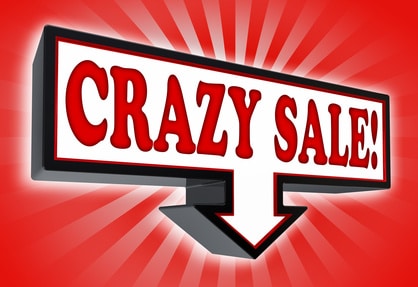 After a recent column, I received an email from Peter, a reader in Saginaw, Mich. He noticed a Walmart flyer advertising a 24 oz box of Kellogg’s Frosted Mini-Wheats for $3.68. Being the smart shopper he is, Peter knew this wasn’t much of a deal since Meijer had recently been selling the same 24 oz boxes for $2.50 each.
After a recent column, I received an email from Peter, a reader in Saginaw, Mich. He noticed a Walmart flyer advertising a 24 oz box of Kellogg’s Frosted Mini-Wheats for $3.68. Being the smart shopper he is, Peter knew this wasn’t much of a deal since Meijer had recently been selling the same 24 oz boxes for $2.50 each.
As Peter noted in his email, Walmart is likely counting on people assuming everything listed in the flyer is a bargain even when it’s not. It’s one of the tricky ways stores try to get shoppers to part with their money.
Here are 10 of the top marketing gimmicks stores use. Check back next week when I’ll share some tips on how to avoid falling into these spending traps.
1. Advertising everyday prices
Just because it is in the sales flyer doesn’t mean it is a deal. Look for terms such as “˜Great Low Price’ which may indicate the store is simply advertising the regular price instead of offering a sale.
2. Endcap and center displays
It may seem like the best deals would be placed in the center aisles and end caps. However, that’s not always the case. Endcaps, in particular, are often used to display items that lend themselves well to impulse purchases (think: sweet and salty snacks) rather than the best deals.
3. Calculating sale percentages off the MSRP
This seems to be a favorite of furniture stores. They say you are saving 60 percent off, but that percentage is based upon the manufacturer’s suggested retail price ““ a price that is often inflated and that almost no one actually sells at. The store’s normal price may be 50 percent off the MSRP so the sale price is actually only 10 percent off.
4. Never to be repeated sales
Another popular tactic used by furniture, housewares and department stores is the “˜one time only sale.’ These sales promise the best prices of the season and say they will never be repeated. Let me tell you, I’ve been tracking sales for a long time, and it is very rare to find a sale so good that it will never be repeated. Don’t buy into the hype.
5. Group pricing
2 for $3, 4 for $5, 10 for $10″¦stores love to price things in groups. However, unless the ad stipulates you must buy a certain quantity to get the sale price, you don’t have to buy that many. Rather than two cream cheeses for $3, you can get one for $1.50.
6. Adding clutter to make you buy more
Cluttered aisles tend to increase sales, and baskets jumbled with items attract shoppers looking for a deal. Some department stores may leave some racks messy because they give the impression of a hot item and encourage other shoppers to stop and take a peak.
7. Placing popular items in the back of the store
Clearance racks in the mall are at the back of the store for the same reason milk is stocked along the grocer’s rear wall. Retailers want you to walk past all their other displays in the hopes something will grab your attention.
8. Making the sales experience hands-on
Once an item is in your hands, you feel some degree of ownership. You might also feel guilty about walking away after the associate has bothered to pull down a display item for you to look at. Both are reasons why store associates may hand an item over rather than simply point you in the right direction.
9. Dropping the dollar sign
 In my experience, this gimmick seems most common at the mall clothing stores. Rather than a pre-printed price tag with $50 on it, the stores have a handwritten tag that say 50–. Something about dropping the dollar sign and handwriting the price makes us think it must be a great deal.
In my experience, this gimmick seems most common at the mall clothing stores. Rather than a pre-printed price tag with $50 on it, the stores have a handwritten tag that say 50–. Something about dropping the dollar sign and handwriting the price makes us think it must be a great deal.
10. Putting the bakery and flowers up front
Finally, grocery stores want you to be in the proper frame of mind to maximize your spending. Delicious bakery smells and bright flower displays are said to put shoppers in a buying mood which is why those departments are likely to greet you when you walk in the door.




